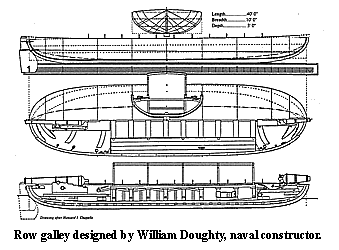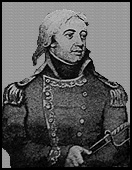 Prince George's County
Prince George's County Celebrates 300 years of history 1696-1996
 Prince George's County
Prince George's County
Celebrates 300
years of history 1696-1996
 by Richard Dolesh and Karin Hansen
by Richard Dolesh and Karin HansenOne of the most fascinating chapters in this tale of our nation's history is the story of Joshua Barney, Commodore of the Chesapeake Bay Flotilla, who with his Flotillamen, defended the fledgling nation. When the British entered the upper Chesapeake Bay in 1813 to attack Washington, Baltimore, or Annapolis, Joshua Barney's ragtag flotilla of gun boats, row galleys, and commandeered ships was virtually all there was to stand in the way of the mighty British Navy. A part of that history will come alive during the Tricentennial celebration of Prince George's County when a replica of one of Joshua Barney's Barges sails the Patuxent, the Potomac, and the Anacostia Rivers again.
Prince George's County Remembers The Maryland-National Capital Park and Planning Commission, in partnership with the Living Classrooms Foundation of Baltimore, will construct a replica of one of the warships of the Chesapeake Bay Flotilla in Bladensburg on the shores of the Anacostia River, at the very spot where Barney's men defended the approach to the Capital in August of 1814. The partnership will have considerable community involvement, and will include students from local schools, particularly Bladensburg High School, and youth-at-risk in alternative education programs, such as the Bladensburg Middle School. In addition to students, adult volunteers will be able to participate in the construction, and then the sailing of this scaled replica of one of the row barges of the Chesapeake Bay Flotilla.
Aided by support from the Town of Bladensburg, the Bladensburg Local Development Corporation, the Prince George's Economic Development Corporation and many other organizations and businesses, the construction of the Barney Barge will kick off a major revitalization and redevelopment of the Anacostia River waterfront in the area now called the "Port Towns of the Anacostia" - Bladensburg, Colmar Manor, and Cottage City.
The old Bladensburg Marina, underutilized and forgotten for years, is being transformed, and by more than just a face-lift. Now named the Historic Bladensburg Waterfront Park, the marina and surrounding park property will be entirely renovated beginning in 1996. Start-up funds of more than $3 million from the State of Maryland and the M-NCPPC will begin the total redevelopment of the waterfront park on both sides of the River, including a pedestrian bridge linking Bladensburg and Colmar Manor, a new public boating facility, historic exhibits, a museum shop, and possibly a restaurant. The waterfront park will be an exciting attraction for not just the community and the state of Maryland, but also for residents of the entire region.
When the Commodore Barney Barge is completed, is will be used on the Patuxent River in the summer and fall of 1996 to re-create and re-enact some of the events of the War of 1812. Among these events could be the "Breakout at St. Leonard's Creek," the flight up the Patuxent to avoid capture by the marauding British, the sinking of the Flotilla above Hills Bridge, and the desperate march to Bladensburg to defend the bridge to the Nation's Capital, culminating in a reenactment of the Battle of Bladensburg on Bladensburg Day, September 21, 1996.
As interesting and fun as it might be to re-create some of the events of the battles of the War of 1812, the real history is far more interesting. It revolves around that courageous yet little known figure of American history, Joshua Barney.

The story of his life at sea is one of adventure and intrigue beginning at the age of thirteen. During the Revolutionary War, Barney became the youngest Commander of a Continental Navy frigate. Tales of his capture by the British and his daring escape were well known. After the defeat of England in America, Barney traveled to Paris to deliver peace documents to Benjamin Franklin. While in France, he was introduced at court and met Marie Antoinette. In 1795, he accepted a position as commander for the French Navy which he held for five years before returning to his home in Maryland. In 1812, Joshua Barney was fifty-three years old and living in Elk Ridge, Maryland. Because of his previous service to France, Barney was not allowed a leading position in the U.S. Navy, but accepted command of the schooner Rossie.
By December of 1812, the Royal Navy was raging across the Tidewater region blockading towns, looting and plundering. The Chesapeake and Delaware Bays were blockaded. The first defeat the British suffered was at the mouth of the Elizabeth River in Virginia when they failed to take Norfolk, but their wrath was so great they sacked the city of Hampton for revenge. As the British invaded the Eastern Shore, the American army was concentrated in Canada and the strategic Chesapeake was relatively undefended. Although something had to be done, America's forces had few reinforcements and little money.
In response, Joshua Barney designed a plan entitled "Defense of the Chesapeake," and submitted it to President Madison. The detailed plan included sketches of gunboats similar to barges, with oars, light sails and one large gun. The small, quick barges, manned by local men would be tricky targets, could keep watch over the enemy and sail into the shallow Chesapeake waters where the larger British gunboats would not dare enter. They were relatively inexpensive to construct, and Barney believed the barges could be sold after the war for commercial use.
In August 1813, Barney was appointed commander of the Chesapeake Flotilla and local shipyards began constructing the barges. Bounties were offered to entice men who would otherwise continue to privateer to enlist. News of the flotilla spread quickly and the British began constructing their own barges on Tangier Island. Although stymied by a shortage of men and supplies, Barney's Chesapeake Flotilla with seven 75' barges, six 50' barges, two gunboats, one row galley, one lookout boat and the flagship Scorpion set sail in April 1814 investigate the Potomac and check any defects in the flotilla.
With eighteen ships and barely a month's supplies, the flotilla sailed from Baltimore on their first mission, to attack Tangier Island and destroy the British barge fleet under construction. While sailing towards Tangier, Barney sighted a group of British soldiers on reconnaissance at St. Jerome's Creek. Barney chose to attack the party, but was forced to make a hasty retreat up the Patuxent River once he saw their warships hidden nearby. The British Commander Barrie of the HMS Dragon blockaded the mouth of the Patuxent and waited for reinforcements from the eighteen gun Jaseur and the thirty-eight gun HMS Loire. Barney continued to retreat up river and landed on the shores of St. Leonard's Creek. Outgunned by more than four to one, Barney had little hope for victory. But, the shallow waters of St. Leonard's Creek and the surrounding high grounds were an excellent location to mount a defense. The ensuing three days of fierce fighting are known as the Battle of the Barges or the First Battle of St. Leonard's Creek. Although the battle ended in a draw, Barney did not lose a single man while the British suffered numerous casualties.
In August, a British invasion forty-eight ships strong arrived in the Chesapeake bound for the little town of Benedict. A contingent of 5,400 men under the command of General Robert Ross landed and began a march north, while Admiral Sir George Cockburn sailed a fleet up the Patuxent. An American army of almost 7,000, many of them untrained militia men, formed. Secretary of State James Monroe and a small squadron scouted the area around Nottingham to watch the British and determine if they were headed for Washington, Annapolis or Baltimore. Once the Americans were sure of the British intent to attack Washington Joshua Barney moved his flotilla upstream and prepared to march 400 of his men to Washington. He left men behind with orders for the flotilla to be destroyed if necessary to avoid British capture.
The British forces moved on to Upper Marlboro under the watch of the Americans who chose to prepare for the attack on Washington rather than engage the superior British troops. On August 24, the British marched towards Bladensburg. At Bladensburg, the British met the ill-prepared American forces under the command of General Tobias Stansbury. Only Joshua Barney, his Flotillamen, and marines under the command of Captain Miller marched from the northeast and engaged the British. After thousands of militia men had retreated, Barney and his men stood their ground and managed a valiant but futile counterattack. Barney was wounded and captured by the British who congratulated him for his gallantry. The devastating American defeat at Bladensburg is called "the Bladensburg Races" in reference to the fleeing American troops. Continuing on to Washington, the British troops looted and burned most of the city including the White House, the Capitol and the Treasury before withdrawing on August 25, 1814.
Following Commander Barney's orders, the flotilla waiting at Pig Point had been destroyed on August 22 to avoid British capture. After quietly settling into the Patuxent River, the remnants of Barney's flotilla remain buried under the river bottom today. Joshua Barney returned to his home in Anne Arundel County and began petitioning Congress for compensation for his men. The wound he received at the Battle of Bladensburg was a bullet deep in his thigh which could not bq removed and which he lived with for three years before it caused a fever that caused his death on December 1, 1818.
Special thanks to Suzie Helman for helping us gather this information for our site.
 Prince
George's Tricentennial Home page.
Prince
George's Tricentennial Home page.